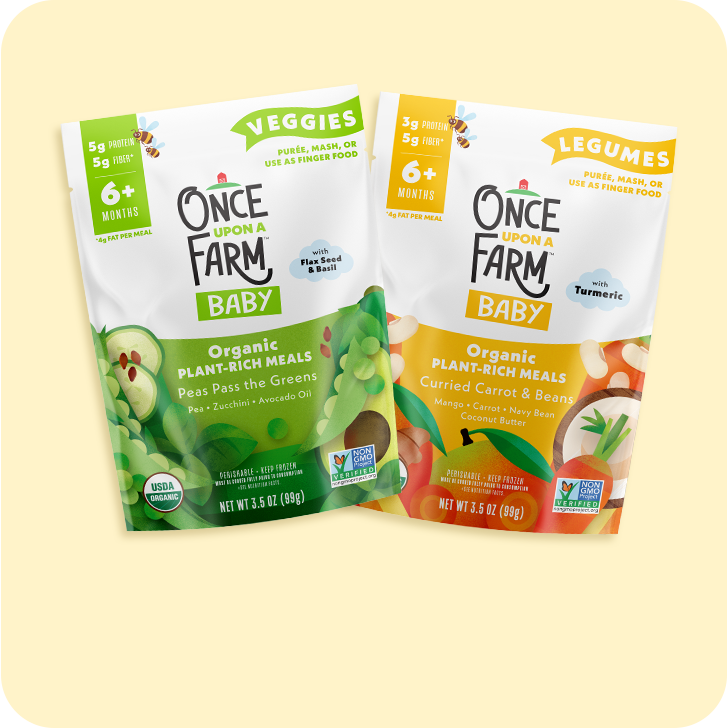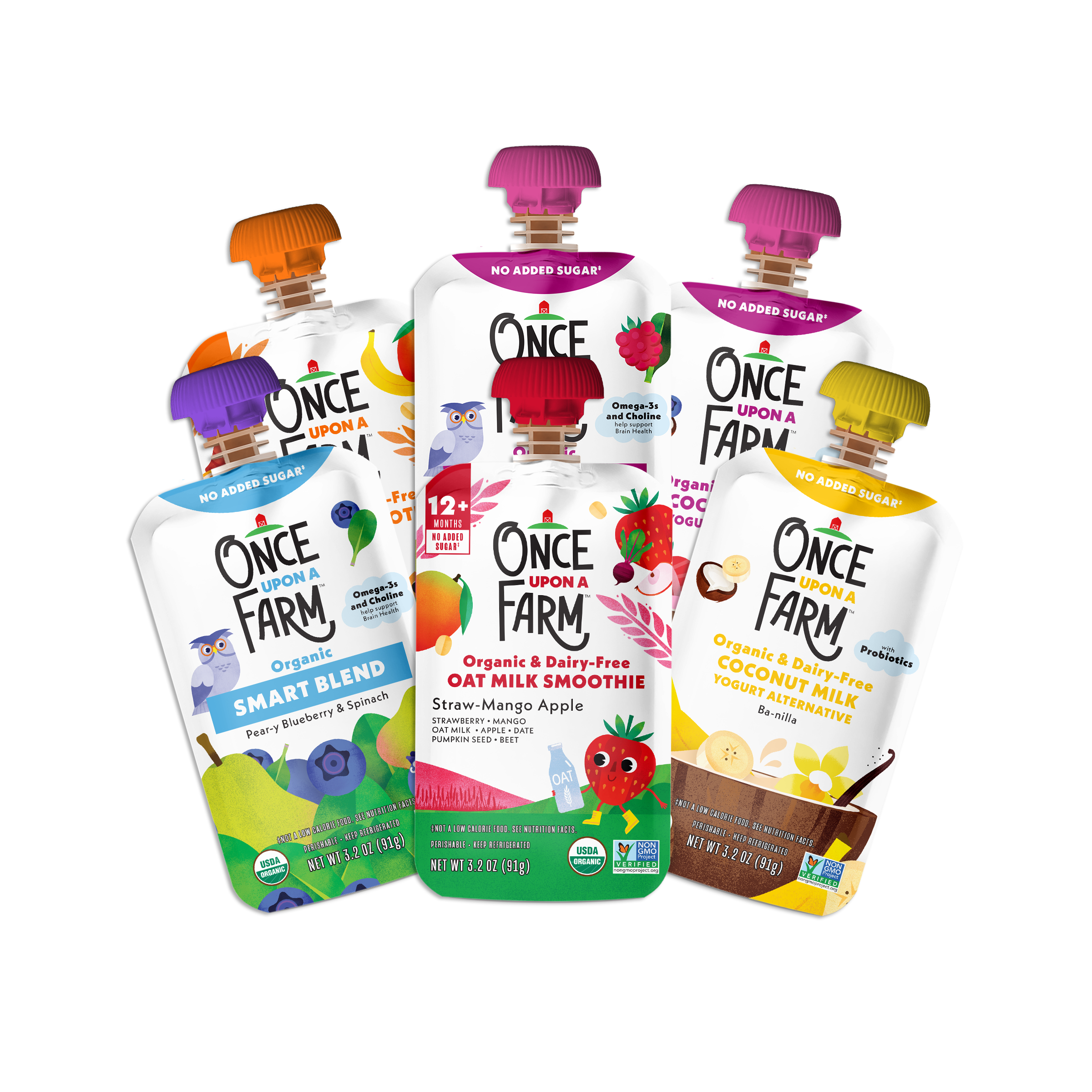As a new parent, almost as soon as your baby is born, you start to think about their future and all the milestones they will one day reach, including those related to food. So, what exactly are these milestones for your baby and toddler, what should you be looking out for, and when? To help you set your expectations and navigate these crucial stages, we spoke with feeding therapist Melanie Potock, MA, CCC-SLP.
1–3 months
Rooting Reflex + Intentional Head Turning
When a baby is born, Potock explains, they have a “rooting reflex that detects a touch on their lips or cheeks and moves toward that stimulation.” It is this reflex that helps them locate food such as breastmilk or formula. “They learn from this reflex and begin to turn their head intentionally during the second month of life.”
Suckling Reflex
From birth, the suckling reflex is also present—this helps baby extract milk from the breast or bottle. “It’s one of the first oral motor patterns that contributes to learning to drink liquids and also plays a role in helping baby consume purées and mashed foods when they first start solids,” Potock says.
4–6 months
Sensory Communication
At this stage, teethers and toys are very important in helping baby prepare to start solids. This is because baby is practicing holding the toy in both hands and bring it to their mouth. As Potock shares, “the feedback from the nerves and muscles in their fingers, hands, and arms helps them understand what they are feeling in their mouth too.” This type of sensory communication will be the same one they experience when they start bringing safe solids to their mouth with their hands or via a preloaded spoon of purée.
Interest in Foods
During this phase, babies are also associating the sight of the breast or bottle with the anticipation of eating. “They may also begin to show interest in what others are eating and reach for solid foods held by an adult or sibling,” Potock explains. Although they may attempt to grasp the food with their palm (the palmer grasp) and put it into their mouth earlier, experts recommend starting solids closer to six months of age.
Physical Signs of Readiness
Beyond showing an interest in foods, Potock says, “Other signs of readiness include, but are not limited to, being able to sit up relatively stable on their own or with some seating support in the high chair and having good head and neck control.”
If you haven’t already done so, Potock also suggests introducing sign language during this stage. This will support baby’s speech and language development and set the stage for less frustration when baby starts solids. “Although baby may not quite have the fine motor control to sign yet (although some do!) they will associate the sign with the meaning, such as signing ‘milk’ for bottle or breast feeding.”
6–8 months
The Biting Reflex
At this stage, babies are mastering another reflex they’ve had since birth, the biting reflex. “Parents may have noticed that their infant appears to bite up and down if they press on baby’s gums or when they are mouthing a toy.” Potock notes. This reflex helps them build the jaw, cheek, and tongue muscles in anticipation of starting solids and learning to chew. “In fact,” she says, “parents will notice babies gaining more control of the movement and doing it intentionally between 6 and 8 months of age.”
Transverse Tongue Reflex
Then there’s the transverse tongue reflex that helps babies move their tongues from side-to-side. This reflex is also present at birth, but babies are learning to control it during this time. “By about 8 months of age,” Potock says, “babies can intentionally move their tongue and push food onto their lateral gumline for chewing and retrieve it from that spot for swallowing!”
While it may be messy (until about 18 months), babies at this age can also learn to drink from a straw, suck from pouches, and even grasp a small, open cup to take a drink.
9–12 months
Emergence of Teeth
“As babies enter their ninth month, so many exciting feeding skills are emerging, as are several new teeth!” Potock shares. While teething can cause discomfort, it also comes with newfound excitement about feeding. Baby will continue to use the palmer grasp for certain foods, but Potock explains that they will also begin practicing the pincer grasp where the thumb and forefinger attempt to hold onto foods as they bring the hand up to the mouth. “The pincer grasp takes time to perfect and a true, controlled, quality pincer grasp won’t be present till about baby’s first birthday.”
Verbal (and Nonverbal) Communication
During this time, baby is likely learning signs and words and will probably respond with looks, vocalizations, signs, and even first words. Potock says food can be very motivating here! “This reciprocal back-and-forth communication between baby and caregiver is so meaningful and can reflect the joy that many babies express at mealtimes.” Signs like “eat”, “drink”, “more”, and “all done” can be very helpful for babies. Words like “mmm”, “more”, and “no” are common responses. This is a great time to connect with baby and boost their communication skills to help understand their needs. “This is called Responsive Feeding,” Potock explains, “and is the model for feeding children recommended by the American Academy of Pediatrics, UNICEF and the World Health Organization.”
12–18 months
Chewing
By baby’s first birthday, they have learned to chew. This happens first through the munching or up-and-down pattern developed at around six months, which then transitions to a more circular “rotary” chew by 18 months. Potock adds, “A rotary chew may not be perfected until shortly after age two, because baby is still developing strength and stability as their face and jaw grows.”
A Slowdown
It’s important to note that after their first birthday, baby’s growth does slow down, which can impact their appetite. This is the time where you may notice your little one becoming a bit pickier. “Continue to offer baby small samples of a variety of foods,” Potock advises, “especially safe foods that require [some] chewing to build those facial muscles and boost along the development of rotary chewing skills.” This can help minimize picky eating in preschool years.
18–24 months
Big Emotions
It’s no surprise that toddlers have big emotions and big reactions. This is because, as your kiddo approaches two, they experience a period of immense cognitive growth. While it can be a lot for parents, it’s a totally normal part of a child’s development. As Potock explains, this can impact feeding, too. “Parents may observe their child being less willing to sit in the high chair or may feel their toddler barely ate anything that day.” As growth slows down, she says, remember appetite does, too. “Toddlers are also very busy and are now walking and toddling about, and much more interested in exploring their environment than sitting down to eat.”
Recognition of Hunger Cues
Potock again advises maintaining responsive feeding practices. “If baby communicates that they would like more during the mealtime, and more is readily available,” she says, “offer another sample and read their cues to see if they are still hungry with each offering.” Allowing baby to decide if they are hungry or full encourages them to listen to their bodies and learn their hunger cues. “These skills gradually become apparent from the second month of life when baby can control turning toward or away from the bottle and are fully established by the early preschool years.”
While these milestones are important markers, remember that each child is unique, as is their developmental path. As always, if you have concerns, speak with your pediatrician.





















